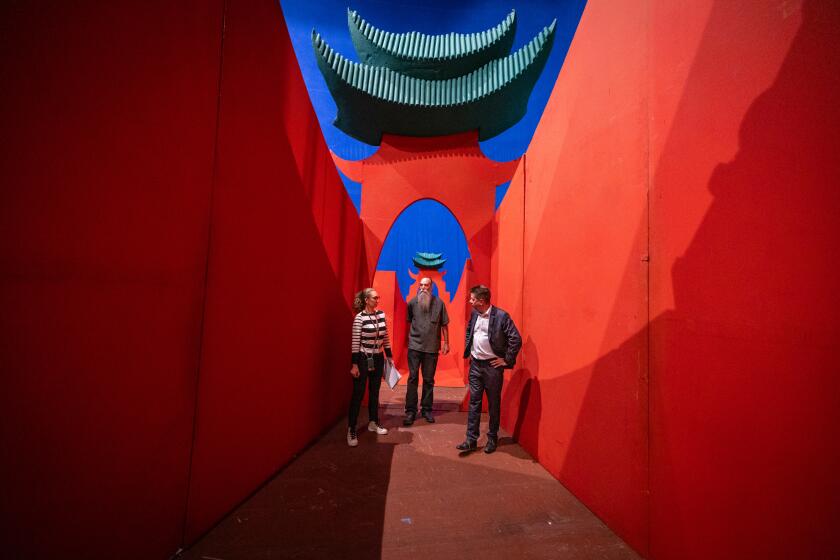Cuba’s Corps Values
Beyond showcasing the current National Ballet of Cuba roster in excerpts from the most familiar 19th century classics, the seven-part program at the Orange County Performing Arts Center on Thursday offered an enlightened view of classicism itself--a view expressing the unique sensibility of the company’s founder, 81-year-old ballet legend Alicia Alonso.
It may seem ungracious to cite Alonso’s age, but her remarkable understanding of 19th century style is a legacy of teachers who danced in the final flowering of that style and shared its secrets and helped her develop her state-of-the-art technique.
That’s the double-edged Cuban tradition on view in Costa Mesa: concern for the expressive context of choreographies that most companies perform as formal showpieces, coupled with a sense of technical daring--finding places for additional high-velocity turns, with hands at rest or held in unexpected, well-nigh impossible positions.
Victor Gili, for example, started the evening as a noble Albrecht in passages from Act 2 of “Giselle,” using his partnering skills to make Galina lvarez seem to float in the air while his acting reinforced the love-beyond-death anguish of their relationship.
Very nice, but later on Gili won all hearts by forgetting nobility and becoming an irresistibly fatuous Franz in the last-act pas de deux from “Coppelia” opposite the wide-eyed Viengsay Valdes. Instead of hunkering down and just pumping out the steps (the common approach nowadays), these artists made her balances in extension and his showy lifts just one facet of their intricate and devastatingly charming byplay. (They’ll dance the complete ballet together on Sunday.)
lvarez also returned Thursday to join Octavio Martin in the White Swan pas de deux, another moonstruck pledge of doomed love but in a later, grander style. The influence of Soviet revisionism has made much of “Swan Lake” an abstraction in recent international stagings, with emotion solely in the music, but the Cubans remind us of an older, more rewarding approach.
Not everything or everyone beggared comparison. Certainly Laura Hormigon and Nelson Madrigal proved mismatched in height and inclined to push too hard against the music in the “Nutcracker” pas de deux. But every excerpt began with corps passages evoking a particular imaginative world, and every duet made the center of that world a place of feeling as well as prowess.
In the “Don Quixote” excerpts, for instance, virtuoso first cousins Alihaydee and Joel Carreno entered after the corps’ showy suite of cape-and knife-dances but never strained to impress and instead delivered their spectacular feats lightly, as if their colleagues had done all the work and they were free to enjoy themselves.
You could argue that the overload of fouettes on the program made it unnecessary to add them to the “Sleeping Beauty” wedding duet.
However, Lorna Feijoo and scar Torrado danced so impeccably, with so many high-speed steps terminating in such sudden, perfect stillness, that the interpolation ended up seeming nothing more than misplaced generosity.
Alonso staged or rechoreographed all the pieces Thursday and a sequence from her 1990 “A Night in the Tropics” closed the evening with celebratory corps sequences punctuated by the briefest appearances of the company stars. Call it a curtain call in motion, a farewell offering that featured lilting music by Gottschalk and the splashiest costumes of red and gold.
Even dancing to tape against alternately minimal and shabby scenery, National Ballet of Cuba remains a monument to the finesse, vitality and vision of its founder. Get it while you can: There are very few places where ballet is so fully alive.
*
National Ballet of Cuba dances the full-length “Coppelia” at 2 and 8 p.m. today and at 2 p.m. Sunday in the Orange County Performing Arts Center, 600 Town Center Drive, Costa Mesa. $20 to $70. (714) 556-ARTS.
More to Read
The biggest entertainment stories
Get our big stories about Hollywood, film, television, music, arts, culture and more right in your inbox as soon as they publish.
You may occasionally receive promotional content from the Los Angeles Times.






